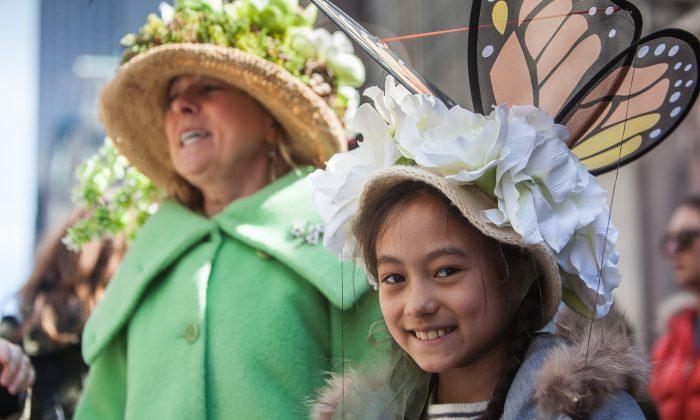NEW YORK—No one knows exactly when the pompous Easter Parade on Fifth Avenue turned into the palooza of quirkiness it is today. Yet this Sunday it proved again to flaunt one of the trademark traits of New Yorkers—the guts to reveal one’s creativity and wear it proudly.
Hardly a parade at all, the event consists of loosely organized groups and individuals promenading up and down Fifth Avenue between 57th and 49th streets, sporting elaborate bonnets of all shapes, often accompanied by vintage clothing.
Mostly floral, the hats’ designs range from high-level artistry to uncontrolled outbursts of bizarre creation. Some don’t hesitate to fit live animals into the outfits. The street is closed to traffic and flooded with onlookers taking pictures of the best hatters.
Angelique Berroya, 11, has been honing her hat decoration skills since she was three. She has presented the results at the parade for the past four years. Berroya spent two whole days crafting her marvelous peacock bonnet. “It’s really fun to get my picture taken,” she said. Her father, Roland, has been bringing her to the parade since she was born.
The Tradition
The tradition of flowery hat display dates back to the mid-nineteen century, when Saint Thomas Church and St. Patrick’s Cathedral started to decorate their interiors with flowers for the Easter Sunday Mass. By that time, the custom of showing respect by wearing one’s best attire on Easter Sunday had already acquired a frivolous flair, with wealthy ladies flaunting their wardrobes. As the church flower decorations grew in intricacy, it was only natural for the ladies to garment their chapeaus accordingly.
Yet, some time in the second half of the twentieth century, the showing off of fancy fashion trends loosened up, and all kinds of contraptions appeared on the avenue.
Upper West Side professional artist Jodie Trapani has been using the parade to vent her ideas for 26 years. “It’s a chance to be out there and bring my art into the world,” she said, adding “It’s a chance to mix with people and make them smile.”
“I like landscaping,” said Jean Lagalia from Queens. She explained that her hat featured a house and a garden from the children’s book, “The Tale of Peter Rabbit,” by Beatrix Potter. “I always try to do something with flowers, but I can’t seem to do pretty, so I do houses,” she said. Last year she fashioned her hat with a replica of the Pemberley mansion from Jane Austen’s “Pride and Prejudice.” “My sister did the book and I did the movie,” she said, laughing.
This year’s parade was a debut for Amabel Chan, a gardener from Connecticut. She came with her husband, two daughters, and two friends. “What an invigorating experience,” she commented. “Lovely to feel part of the energy.”
Her younger daughter Grace, 10, acknowledged the amount of attention she was getting was a little bit embarrassing. Her bonnet was decorated with white flowers and a large butterfly, ingeniously made to flap its wings at Grace’s command. She designed the hat herself.
Chan’s hat sported professionally arranged flowers and greenery. “We got together last night with all of our accessories, put them out on a table with a bottle of wine, and this is what we came up with,” Chan’s friend Heidi Holzer said.






Friends Read Free